 Lotus Development Corp.
Lotus Development Corp.
1-2-3
Lotus 1-2-3 was a DOS-based spreadsheet released by Lotus Development Corporation in January 1983.
Seeing the success of VisiCalc on the Apple II for business number crunching, Lotus jumped ahead by launching a three-in-one tool that included spreadsheet, charting and basic database functionality (hence the name).
In no time from launch, 1-2-3 became the #1 standard in PC spreadsheets, overtaking all other competitors including Multiplan and Computer Associates' SuperCalc. In its first year, Lotus Development Corp went from small-time software company to a net worth of $150M, thanks to the overwhelming demand for the IBM PC and the need for a "killer" app that was the spreadsheet. In October 1983 they went public. By December of that year, Lotus had 300 employees and reported an annual revenue of $53M. A year later, they had 2 products on the market: 1-2-3 and Symphony. 1984's annual report demonstrated their huge growth, at $156.9M annual revenue and now 741 employees.
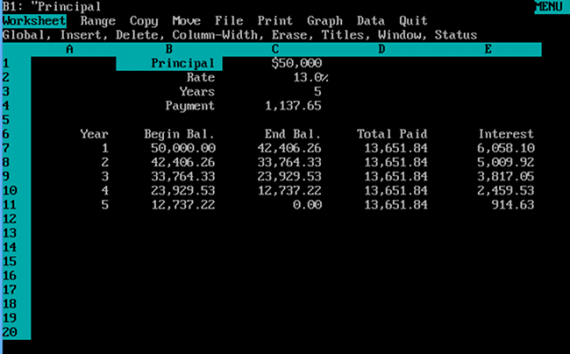
1-2-3, with its menu accessed by hitting the '/' key
Release 2 was released in September 1985, and introduced macros with syntax and commands similar to a BASIC interpreter. Also new to 1-2-3 in v2.0 were add-ins, better memory support for those with expanded memory, and support for 80x87 math coprocessors. It also included more Symphony-like features with its macros, 39 new functions, as well as speeding up the program.
In January 1989, Lotus 1-2-3 Release 2.01 was the top-selling software product, followed by WordPerfect 5 and Norton Utilities Advanced Edition 4.5. They put together a "Value Pack" in late 1988 to help drive sales until Release 3 was ready. This was a handful of utilities which, among other things, removed copy protection and provided a 43-line display on EGA adapters.
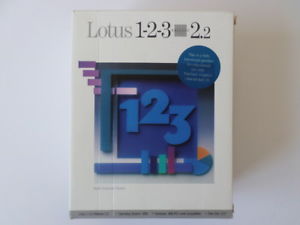 After a long delay from its announcement at the Lotus Week celebration in Boston in April 1987 to its actual release in November, Release 2.2 gave the application better performance, automated macro tools, and presentation-quality graphics. Also announced was Release 3, though this was made available much earlier, in July. Both products cost the same at $495 (the same as Microsoft Excel v2.1 and Borland Quattro Pro at the time). It came on six 3.5" 720KB diskettes. Release 3 marked the transition from being written in Assembly Language to C. Since this was written from the ground up, there were notable delays before its launch. Furthermore, the nature of the new code meant it required a higher-end PC to run. Because of this, Lotus decided to create an updated version on the old code base, called R2.2, for low-end PCs, and the new R3.0 for newer PCs. Release 2.2 could run on a dual-floppy system with an 8088 CPU and as little as 320 KB of RAM. Release 3.0 required a 286 or 386 processor, a hard disk, and 1 MB of memory (3 MB if running in OS/2).
After a long delay from its announcement at the Lotus Week celebration in Boston in April 1987 to its actual release in November, Release 2.2 gave the application better performance, automated macro tools, and presentation-quality graphics. Also announced was Release 3, though this was made available much earlier, in July. Both products cost the same at $495 (the same as Microsoft Excel v2.1 and Borland Quattro Pro at the time). It came on six 3.5" 720KB diskettes. Release 3 marked the transition from being written in Assembly Language to C. Since this was written from the ground up, there were notable delays before its launch. Furthermore, the nature of the new code meant it required a higher-end PC to run. Because of this, Lotus decided to create an updated version on the old code base, called R2.2, for low-end PCs, and the new R3.0 for newer PCs. Release 2.2 could run on a dual-floppy system with an 8088 CPU and as little as 320 KB of RAM. Release 3.0 required a 286 or 386 processor, a hard disk, and 1 MB of memory (3 MB if running in OS/2).
While both versions added new features, they weren't aligned with each other. Release 3 offered 3D worksheets (a stack of connected worksheets in the same file), links to external databases like dBase III, and the ability to see a graph and worksheet simultaneously. With its better memory management it could theoretically handle 256 worksheets at once, with each the size of the single worksheet that Release 2.2 can use, at 8,192 rows by 256 columns. Release 2.2 offered none of these features, but did come bundled with Allways, an add-in that could produce output every bit as attractive as anything that Excel could do. With this, Release 2.2 could produce professional-looking output that Release 3 could not. It still contained the old "PrintGraph", though Allways superceded this acros the board. Setting Sheets in Release 2.2 gave you an overall view of relevant settings for a given function - this too was lacking in Release 3, though this feature would be added in a later release.
Due to the delays, Microsoft's Windows operating system was starting to gather support, and Excel was looking to be the more attractive option for consumers.
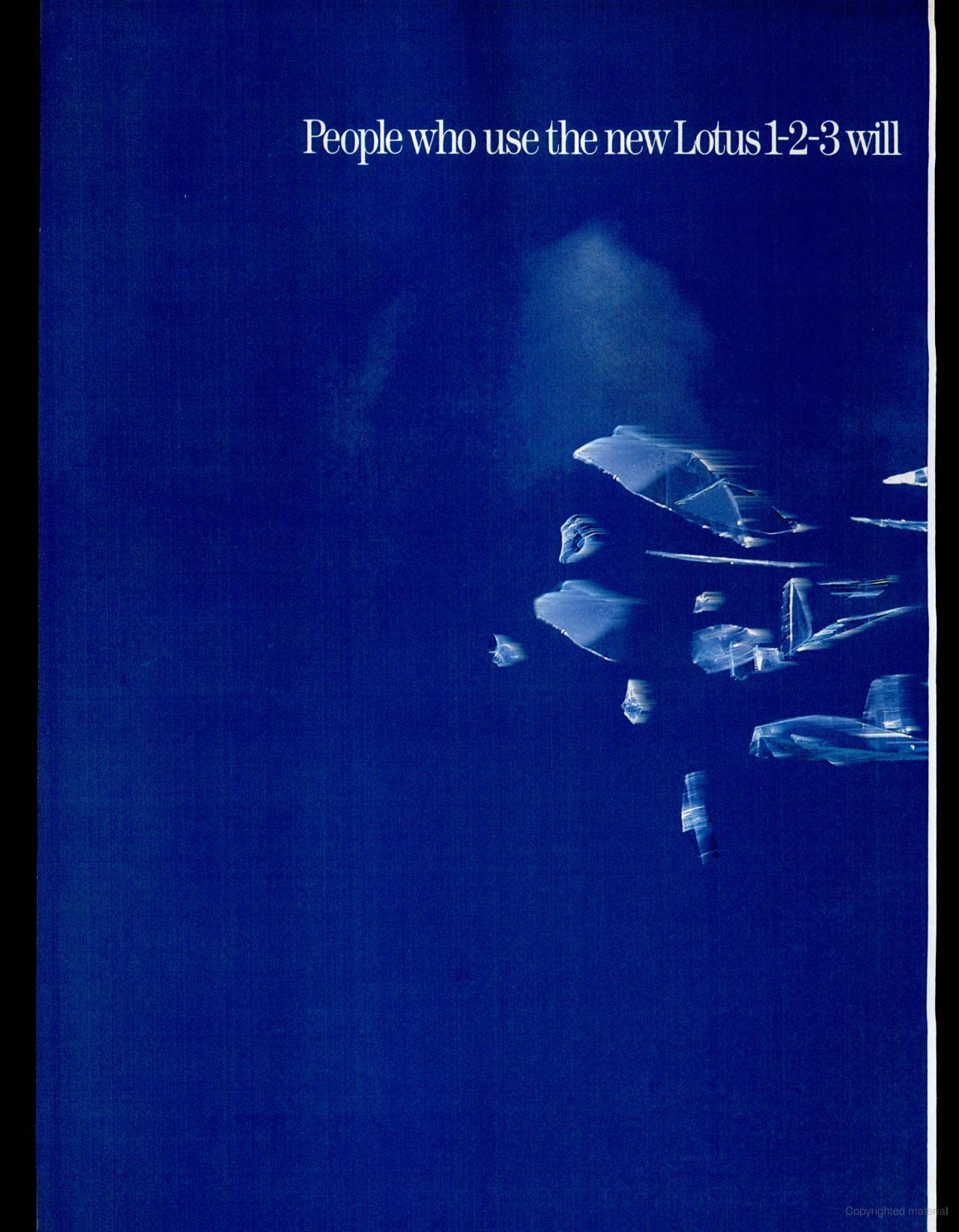
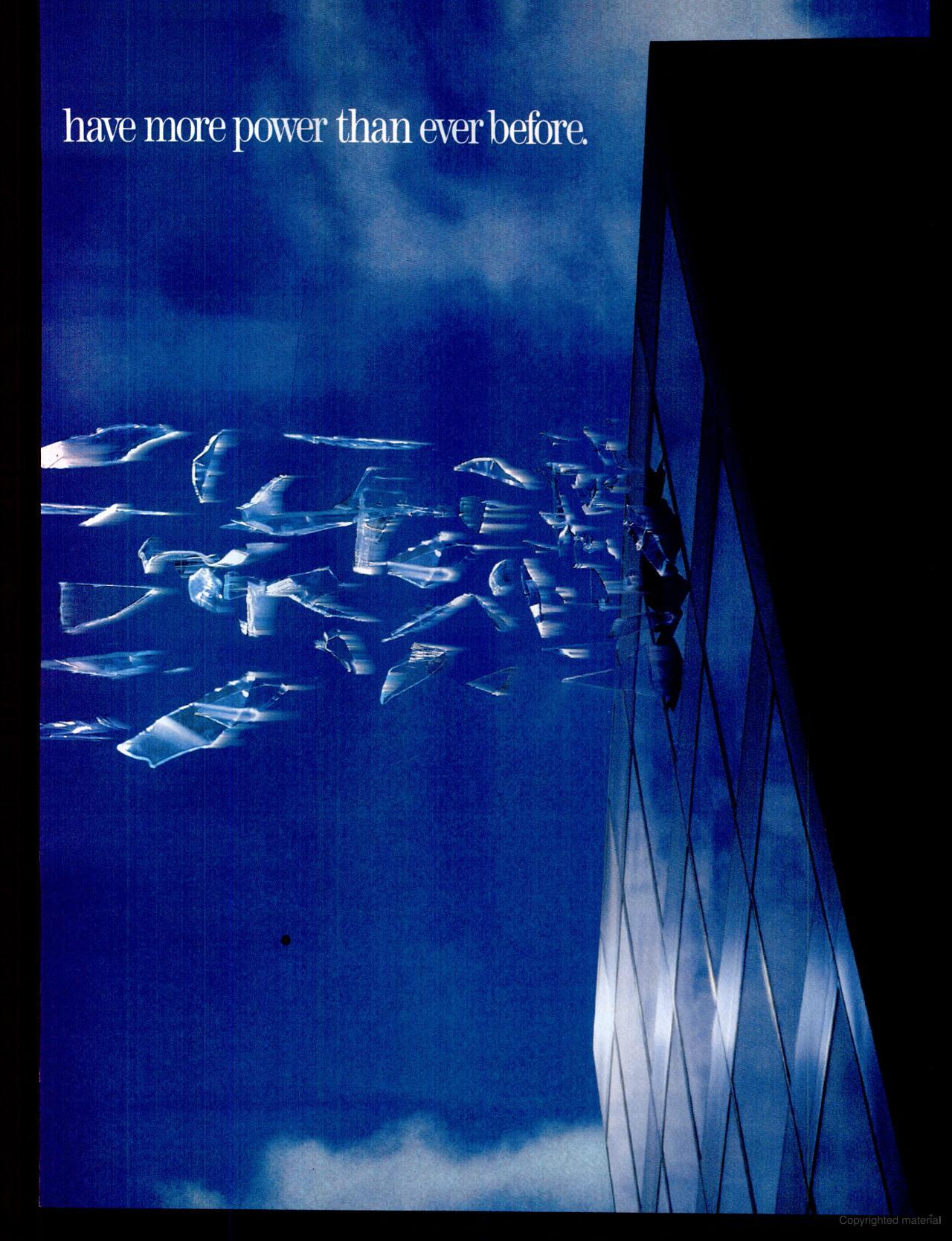
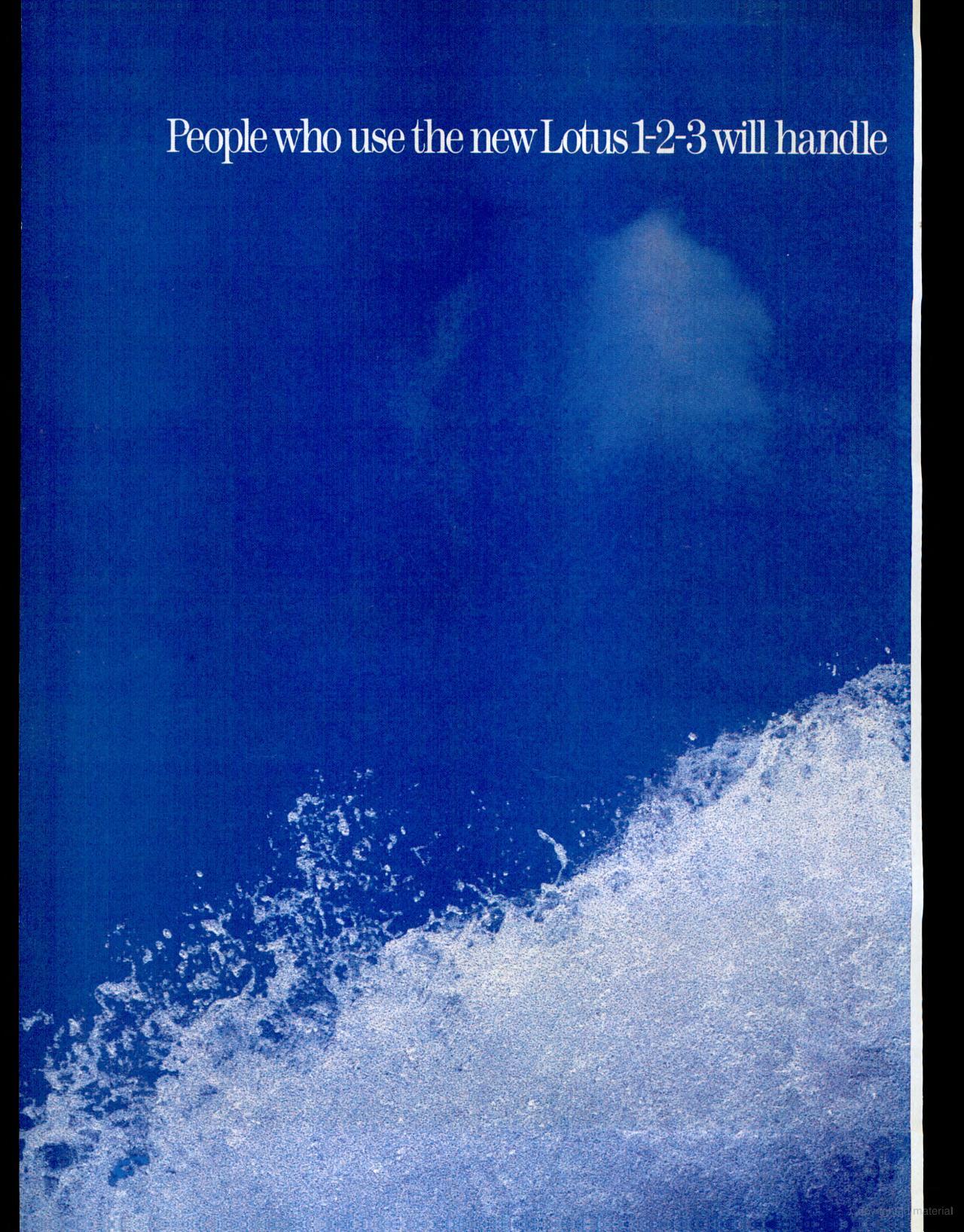
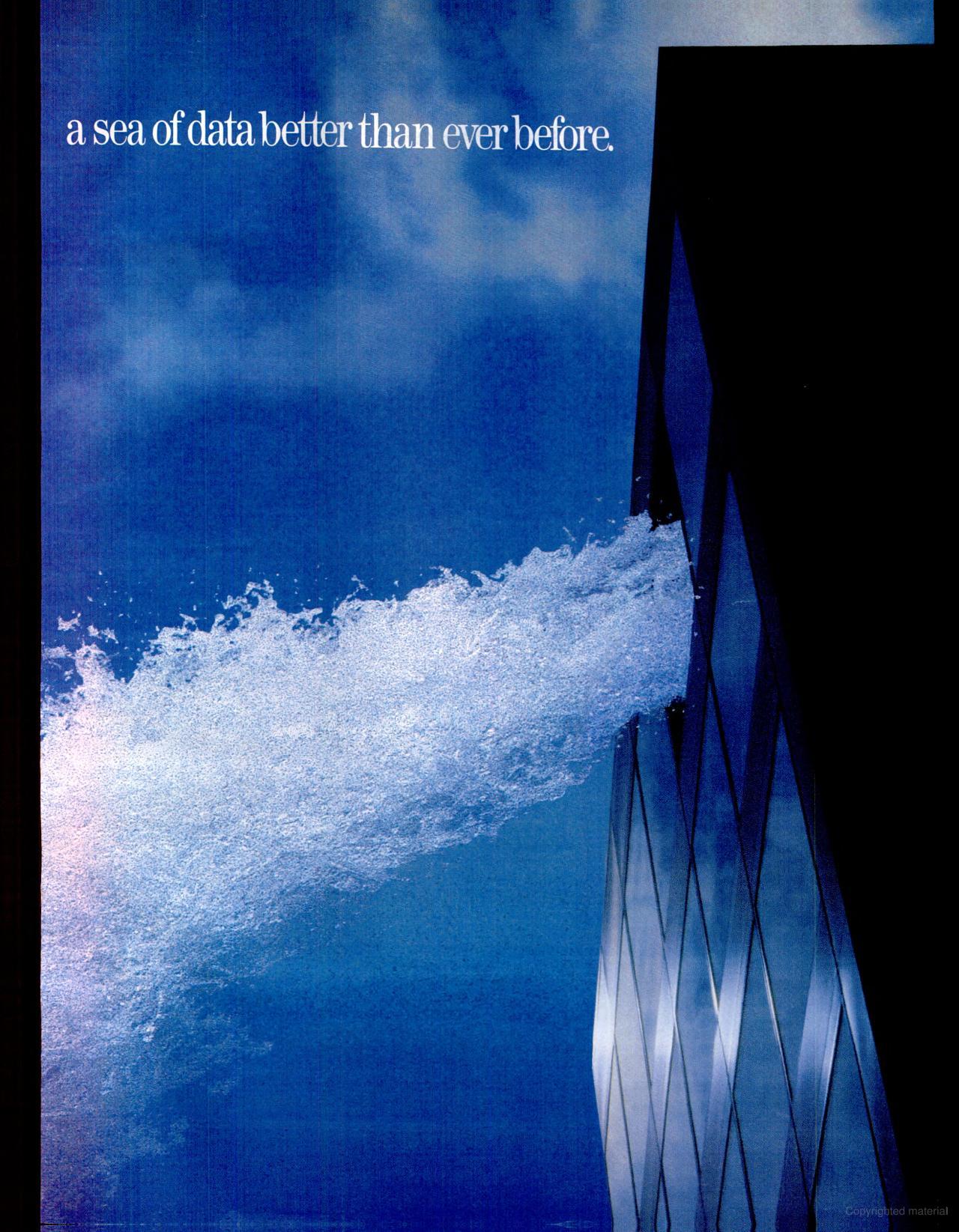
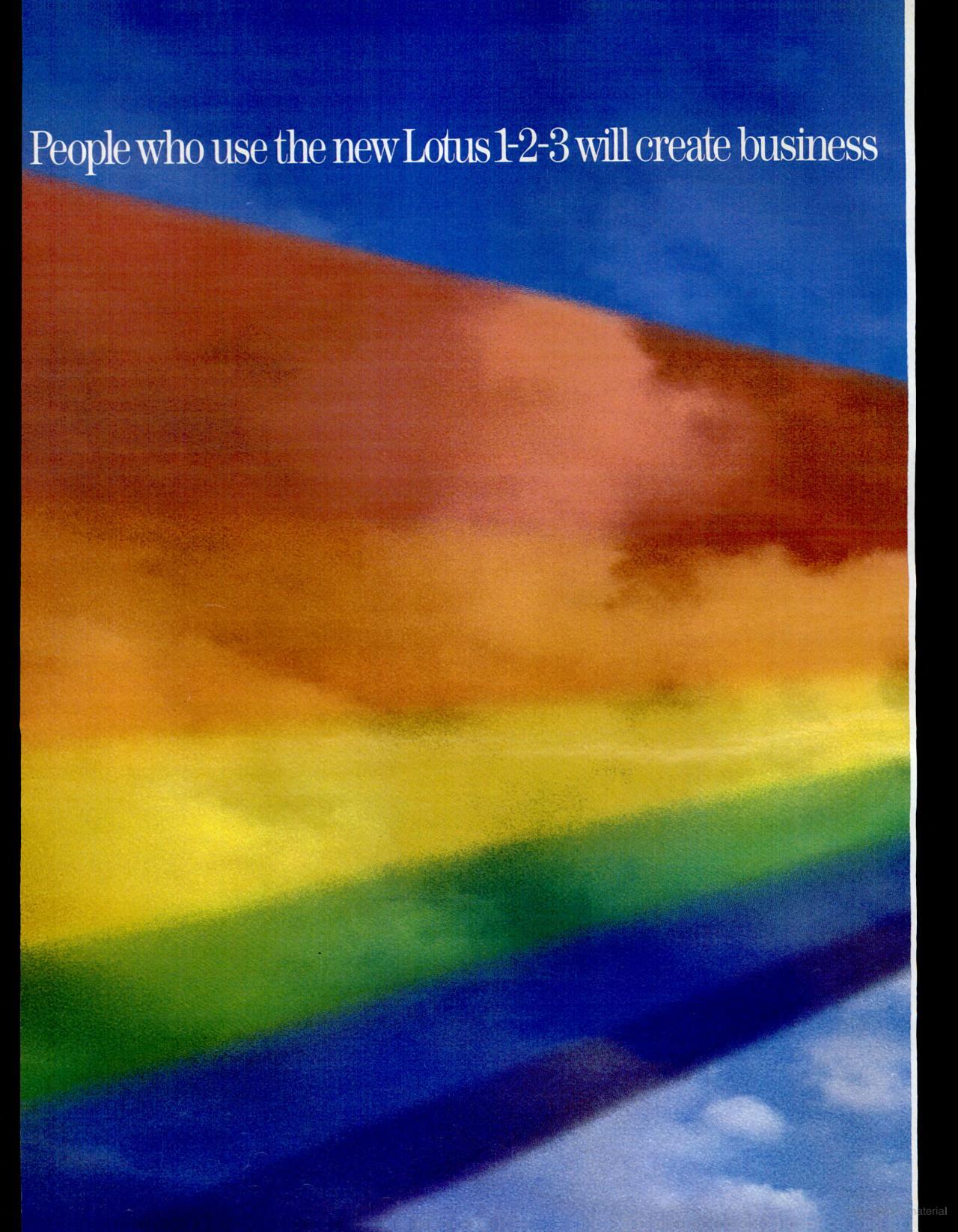
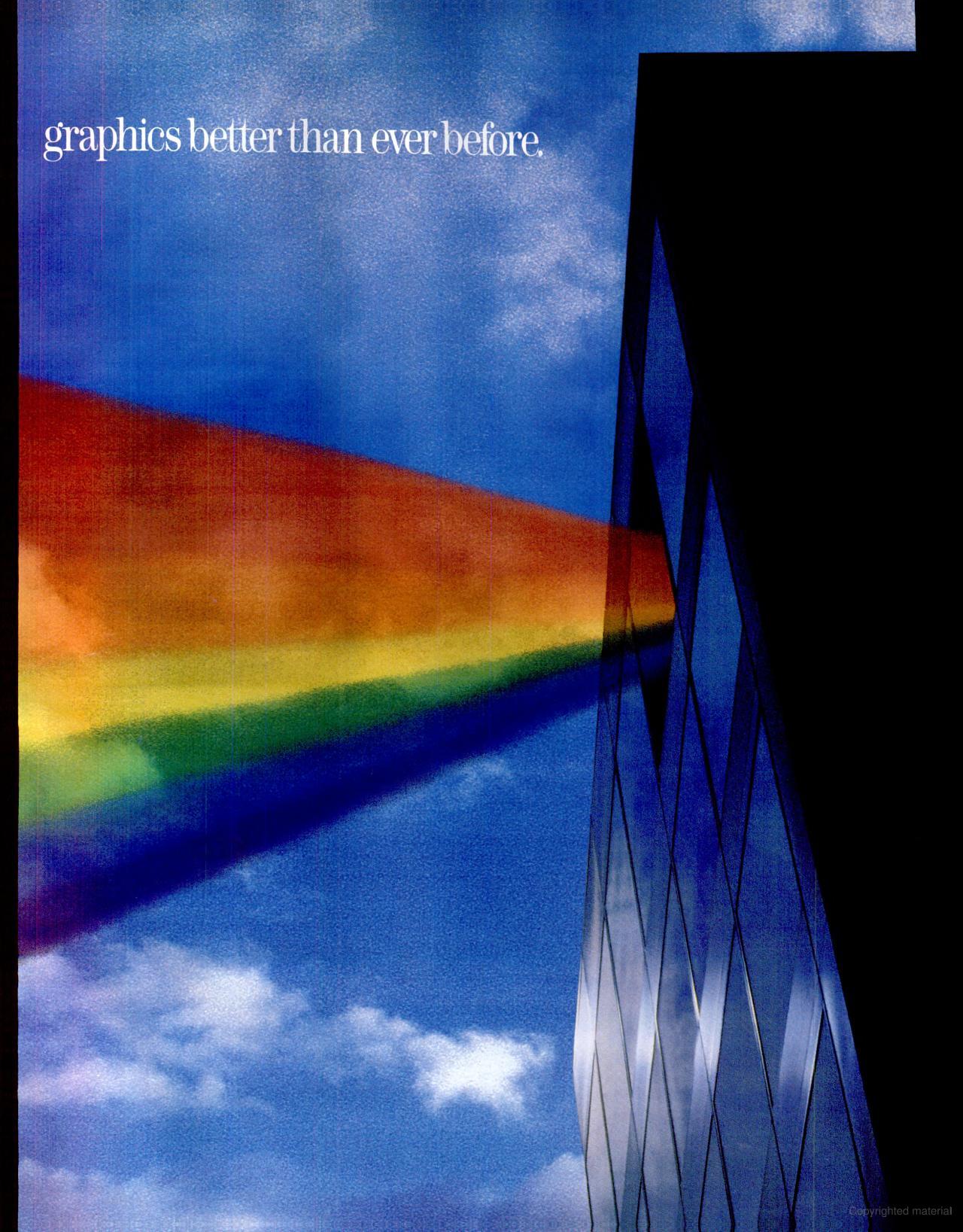
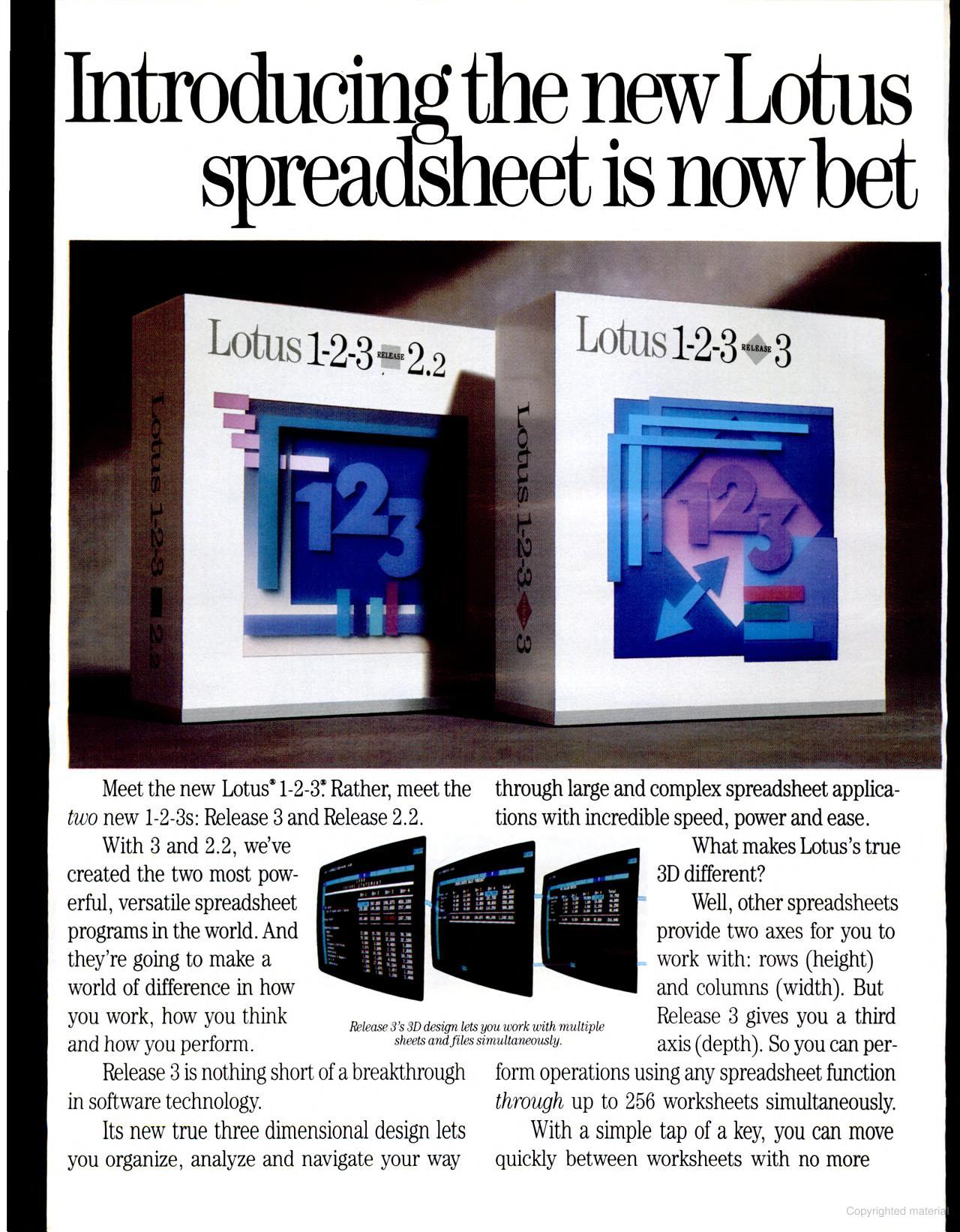
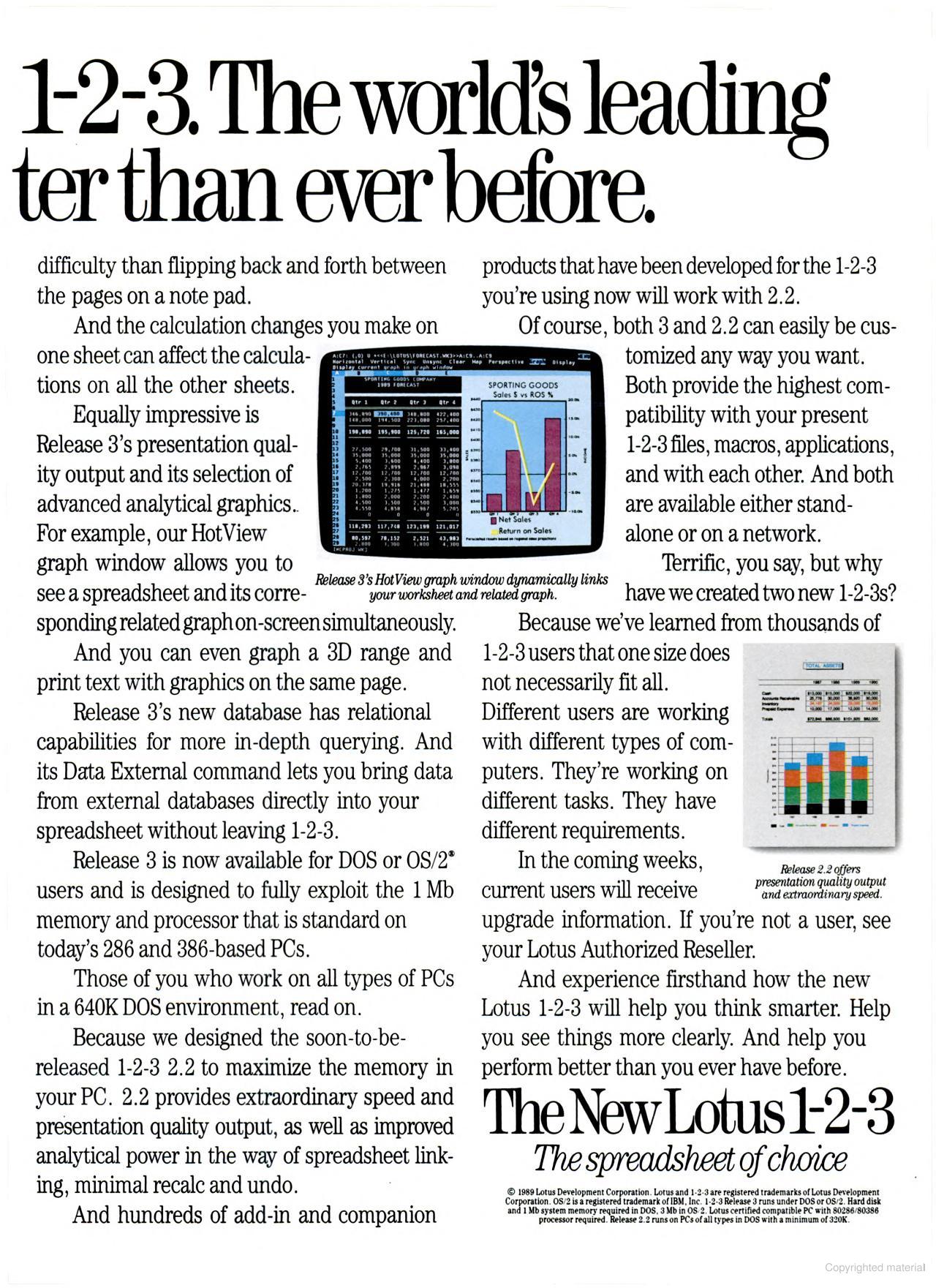
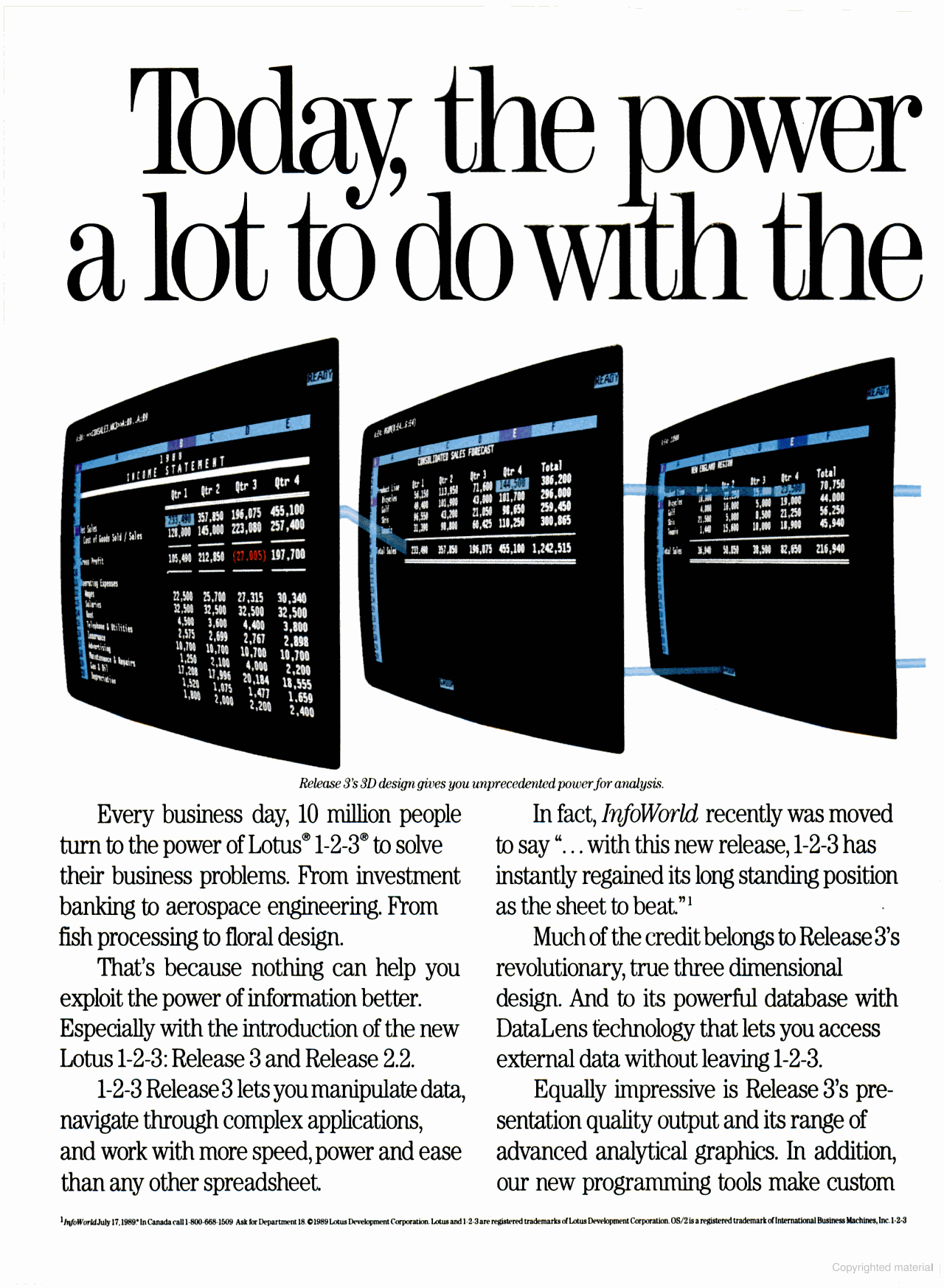
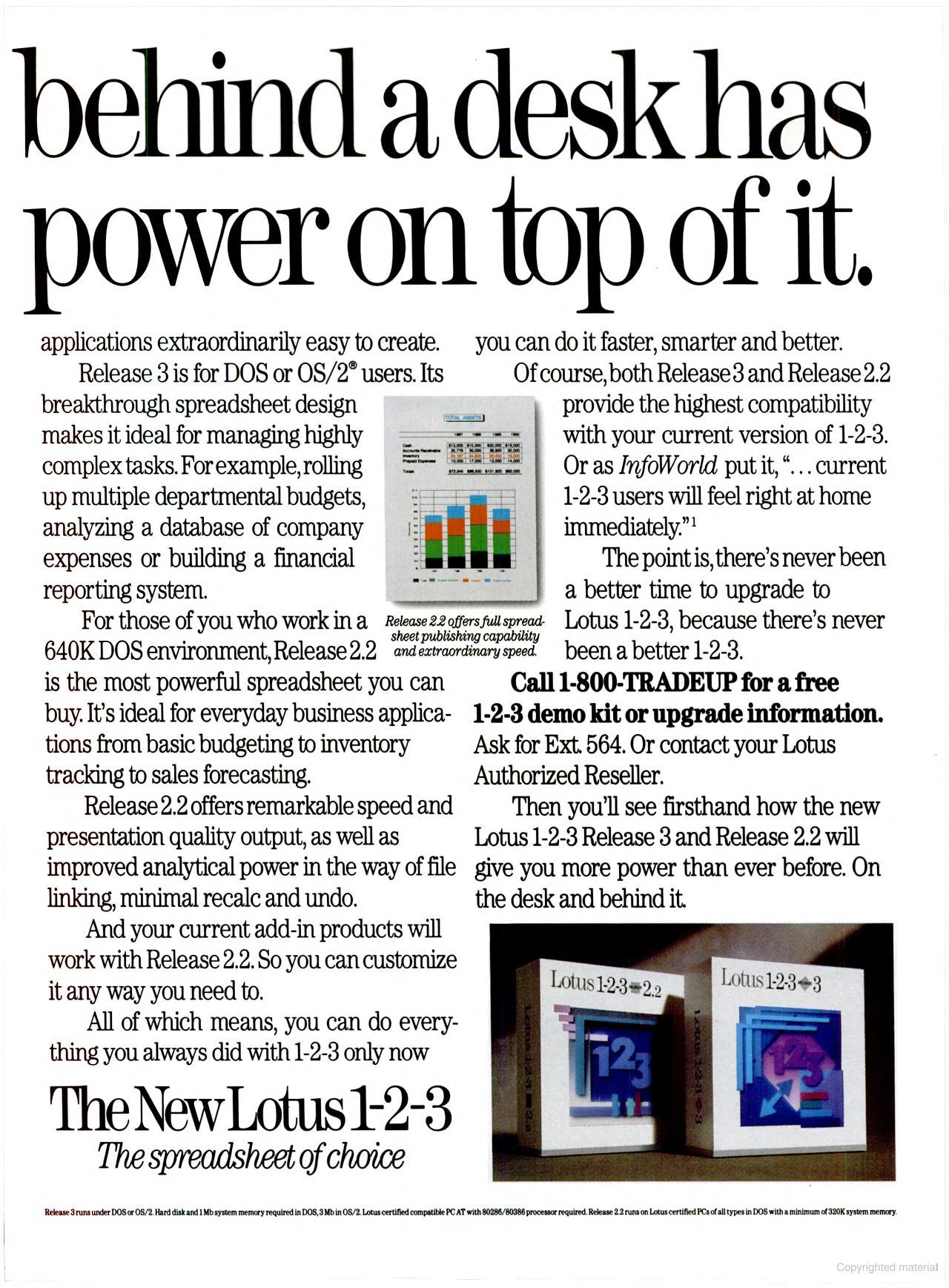
A huge 8-page advertising spread
in PC Magazine, August & November 1989
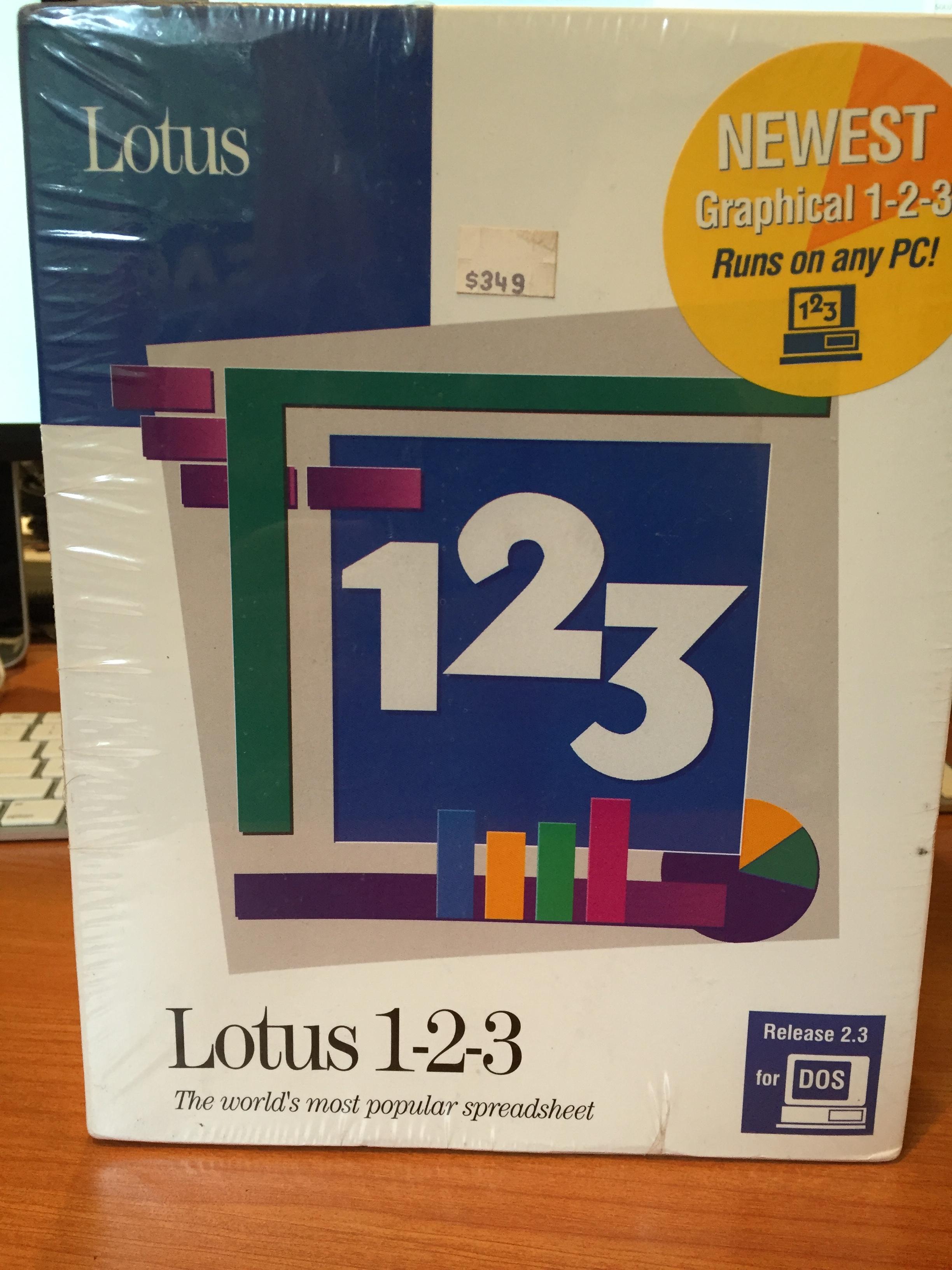 Release 2.3 was released in 1991, and brought WYSIWYG (What You See Is What You Get) editing to the v2.x line for those who had VGA, EGA, high-res CGA or Hercules Graphics cards. Installation on a hard disk took 5 MB.
Release 2.3 was released in 1991, and brought WYSIWYG (What You See Is What You Get) editing to the v2.x line for those who had VGA, EGA, high-res CGA or Hercules Graphics cards. Installation on a hard disk took 5 MB.
Release 2.4 came along in 1992, and added icons and additional tools. This was the final release that supported only 2D spreadsheets. The final version for 8088/8086 "Real" mode-only PCs was v2.4J, in July 1995.
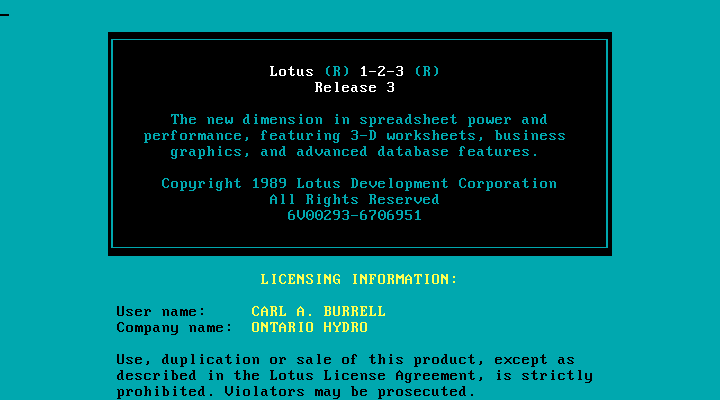
Release 3.1 and 3.1+ which launched in 1990 added WYSIWYG capabilities and support for larger files up to 64 MB in size. This version required 1 MB of system RAM and 5 MB free hard disk space.
Release 3.4 was similar to Release 2.4 in that it supported better charts, had improved performance, and support for icons.
Release 4 was the last released for DOS, and came out in May 1994. The user interface was overhauled once more, and added support for versioning of files, a spell checker, context-sensitive help, and cell commands.
1-2-3 lived on under Windows from 1991 until 2002 (after Lotus had been bought by IBM). It was only toppled from its podium when Microsoft brought out Office which included their spreadsheet application, Excel. With the rise of Windows 3.0 and 3.1, and with it Excel, the Lotus flagship product was behind the curve on compatibility, performance and functionality.